 | –≠–ª–µ–∫—Ç—Ä–æ–Ω–Ω—ã–π –∫–æ–º–ø–æ–Ω–µ–Ω—Ç: TDA3665AT | –°–∫–∞—á–∞—Ç—å:  PDF PDF  ZIP ZIP |

DATA SHEET
Preliminary specification
File under Integrated Circuits, IC01
2000 Apr 25
INTEGRATED CIRCUITS
TDA3665
Very low dropout voltage/quiescent
current 8.5 V voltage regulator

2000 Apr 25
2
Philips Semiconductors
Preliminary specification
Very low dropout voltage/quiescent current
8.5 V voltage regulator
TDA3665
FEATURES
∑
Fixed 8.5 V, 100 mA regulator
∑
Supply voltage range up to 33 V (45 V)
∑
Very low quiescent current of 15
µ
A (typical value)
∑
Very low dropout voltage
∑
High ripple rejection
∑
Very high stability:
≠ Electrolytic capacitors: Equivalent Series Resistance
(ESR) < 30
at I
REG
25 mA (see Fig.6)
≠ Other capacitors: 100 nF at 200
µ
A
I
REG
100 mA.
∑
Pin compatible family TDA3662 to TDA3666
∑
Protections:
≠ Reverse polarity safe (down to
-
25 V without high
reverse current)
≠ Negative transient of 50 V (R
S
= 10
and
t < 100 ms)
≠ Able to withstand voltages up to 18 V at the output
(supply line may be short-circuited)
≠ ESD protection on all pins
≠ DC short-circuit safe to ground and V
P
of the
regulator output
≠ Temperature protection (at T
j
> 150
∞
C).
GENERAL DESCRIPTION
The TDA3665 is a fixed 8.5 V voltage regulator with a very
low dropout voltage and quiescent current, which operates
over a wide supply voltage range.
The IC is available as:
∑
TDA3665: V
P
45 V,
-
40
∞
C
T
amb
+125
∞
C and
SO4 package (automotive)
∑
TDA3665AT: V
P
45 V,
-
40
∞
C
T
amb
+125
∞
C and
SO8 package (automotive).
QUICK REFERENCE DATA
ORDERING INFORMATION
SYMBOL
PARAMETER
CONDITIONS
MIN.
TYP.
MAX.
UNIT
Supply
V
P
supply voltage
regulator on
TDA3665
3
14.4
45
V
TDA3665AT
3
14.4
45
V
I
q
quiescent supply current
V
P
= 14.4 V; I
REG
= 0 mA
-
15
30
µ
A
Voltage regulator
V
REG
output voltage
11.5 V
V
P
22 V; I
REG
= 0.5 mA
8.08
8.5
8.92
V
11.5 V
V
P
45 V; I
REG
= 0.5 mA
8.0
8.5
9.0
V
V
P
= 14.4 V;
0.5 mA
I
REG
100 mA
8.0
8.5
9.0
V
V
REG(drop)
dropout voltage
V
P
= 7.9 V; I
REG
= 50 mA;
T
amb
85
∞
C
-
0.18
0.3
V
TYPE
NUMBER
PACKAGES
NAME
DESCRIPTION
VERSION
TDA3665
SO4
plastic small outline package; 4 leads; body width 3.5 mm
SOT223-1
TDA3665AT
SO8
plastic small outline package; 8 leads; body width 3.9 mm
SOT96-1

2000 Apr 25
3
Philips Semiconductors
Preliminary specification
Very low dropout voltage/quiescent current
8.5 V voltage regulator
TDA3665
BLOCK DIAGRAM
handbook, halfpage
MBL137
REGULATOR
2, 4 (2, 3, 6, 7)
3 (1)
GND
1 (8)
REG
VP
BAND GAP
TDA3665
THERMAL
PROTECTION
Fig.1 Block diagram.
Pin numbers in brackets refer to the SO8 version.
PINNING
Note
1. For the SO8 package all pins GND are connected to the lead frame and can also be used to reduce the total thermal
resistance R
th(j-a)
by soldering these pins to a ground plane. The ground plane on the top side of the PCB acts like a
heat spreader.
SYMBOL
PIN
DESCRIPTION
SO4
SO8
V
P
1
8
supply voltage
GND
2 and 4
2, 3, 6 and 7
ground; note 1
REG
3
1
regulator output
n.c.
-
4 and 5
not connected
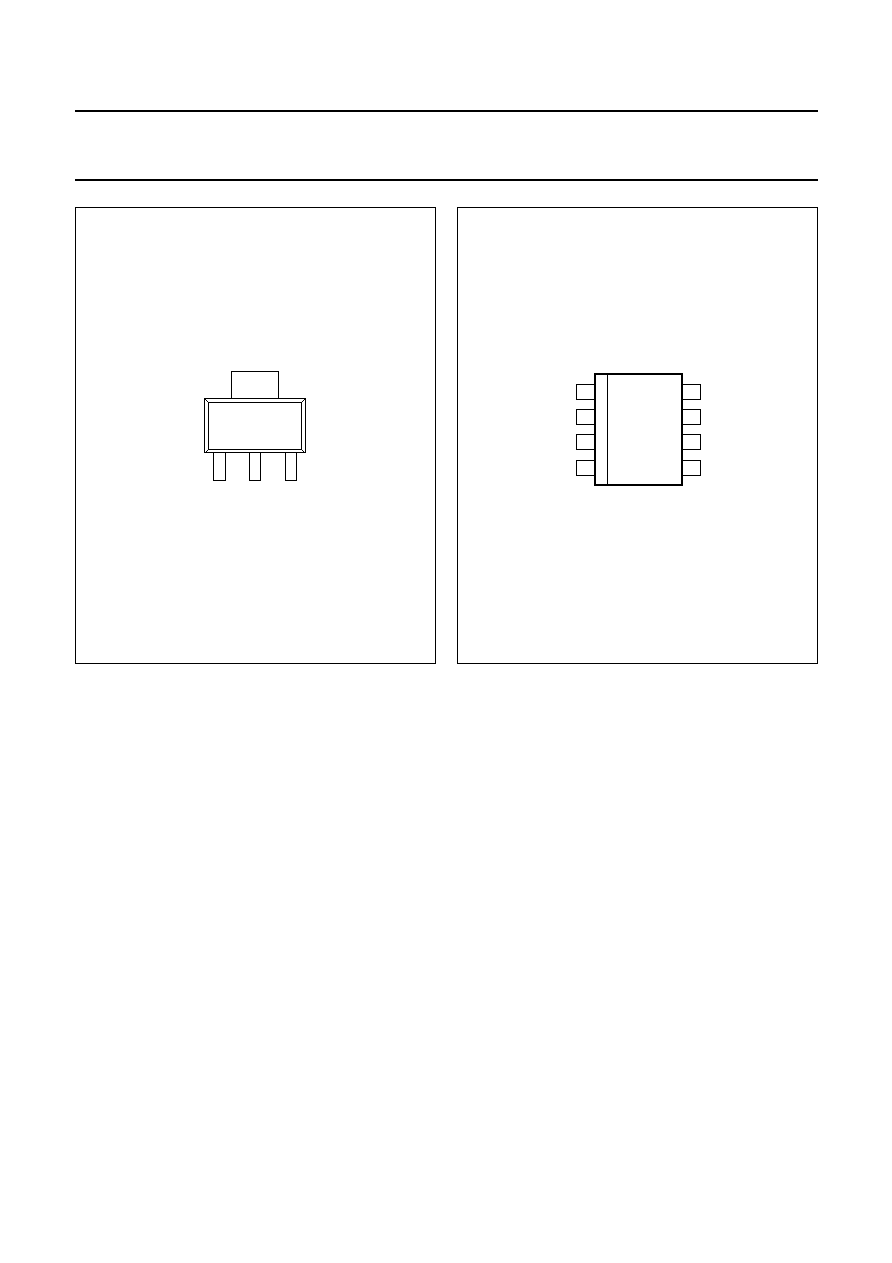
2000 Apr 25
4
Philips Semiconductors
Preliminary specification
Very low dropout voltage/quiescent current
8.5 V voltage regulator
TDA3665
handbook, halfpage
1
3
2
4
GND
MGU147
GND
TDA3665
VP
REG
Fig.2 Pin configuration of SO4.
handbook, halfpage
1
2
3
4
8
7
6
5
MBL126
TDA3665AT
VP
GND
GND
GND
n.c.
n.c.
GND
REG
Fig.3 Pin configuration of SO8.
FUNCTIONAL DESCRIPTION
The TDA3665 is a fixed 8.5 V regulator which can deliver
output currents up to 100 mA. The regulator is available in
SO8 and SO4 packages. The regulator is intended for
portable, mains, telephone and automotive applications.
To increase the lifetime of batteries, a specially built-in
clamp circuit keeps the quiescent current of this regulator
very low, also in dropout and full load conditions.
The regulator remains operational down to very low supply
voltages and below this voltage it switches off.
A temperature protection circuit is included which switches
off the regulator output at a junction temperature
above 150
∞
C.
A new output circuit guarantees the stability of the
regulator for a capacitor output circuit with an ESR up
to 22
(see Figs 5 and 6). This is very attractive as the
ESR of an electrolytic capacitor increases strongly at low
temperatures (no expensive tantalum capacitor is
required).
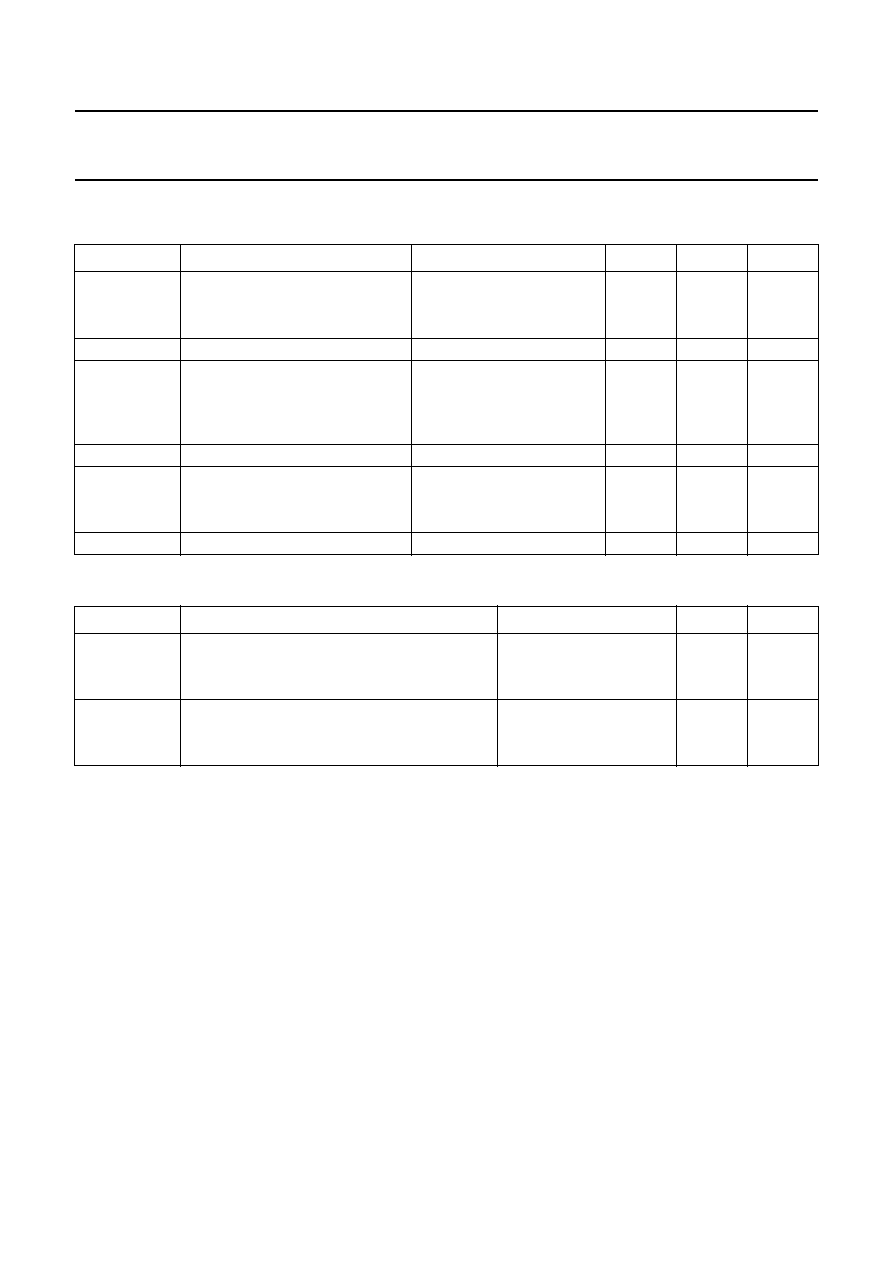
2000 Apr 25
5
Philips Semiconductors
Preliminary specification
Very low dropout voltage/quiescent current
8.5 V voltage regulator
TDA3665
LIMITING VALUES
In accordance with the Absolute Maximum Rating System (IEC 60134).
THERMAL CHARACTERISTICS
QUALITY SPECIFICATION
In accordance with
"SNW-FQ-611E".
SYMBOL
PARAMETER
CONDITIONS
MIN.
MAX.
UNIT
V
P
supply voltage
TDA3665
-
45
V
TDA3665AT
-
45
V
V
P(rp)
reverse polarity supply voltage
non-operating
-
-
25
V
P
tot
total power dissipation
TDA3665AT
temperature of copper area
is 25
∞
C
-
4.1
W
TDA3665
T
amb
= 25
∞
C
-
5
W
T
stg
storage temperature
non-operating
-
55
+150
∞
C
T
amb
ambient temperature
operating
TDA3665
-
40
+125
∞
C
TDA3665AT
-
40
+125
∞
C
T
j
junction temperature
operating
-
40
+150
∞
C
SYMBOL
PARAMETER
CONDITIONS
VALUE
UNIT
R
th(j-a)
thermal resistance from junction to ambient
SO8
in free air; soldered in
125
K/W
SO4
in free air; soldered in
100
K/W
R
th(j-c)
thermal resistance from junction to case
SO8
to centre pins; soldered in
30
K/W
SO4
in free air
25
K/W

2000 Apr 25
6
Philips Semiconductors
Preliminary specification
Very low dropout voltage/quiescent current
8.5 V voltage regulator
TDA3665
CHARACTERISTICS
V
P
= 14.4 V; T
amb
= 25
∞
C; measured with test circuit (see Fig.4); unless otherwise specified.
Notes
1. The regulator output will follow V
P
if V
P
< V
REG
+ V
REG(drop)
.
2. Limiting values as applicable for both device types: V
P
45 V and
-
40
∞
C
T
amb
+125
∞
C.
SYMBOL
PARAMETER
CONDITIONS
MIN.
TYP.
MAX.
UNIT
Supply voltage: pin V
P
V
P
supply voltage
regulator operating; note 1
TDA3665
3
14.4
45
V
TDA3665AT
3
14.4
45
V
I
q
quiescent supply current
V
P
= 4.5 V; I
REG
= 0 mA
-
10
-
µ
A
V
P
= 14.4 V; I
REG
= 0 mA
-
15
30
µ
A
9.5 V
V
P
22 V; I
REG
= 10 mA
-
0.2
0.5
mA
9.5 V
V
P
22 V; I
REG
= 50 mA
-
1.4
2.5
mA
Regulator output: pin REG; note 2
V
REG
output voltage
11.5 V
V
P
to 22 V;
I
REG
= 0.5 mA
8.08
8.5
8.92
V
0.5 mA
I
REG
100 mA;
T
amb
125
∞
C
8.0
8.5
9.0
V
9.5 V
V
P
45 V;
I
REG
= 0.5 mA; T
amb
125
∞
C
8.0
8.5
9.0
V
V
REG(drop)
dropout voltage
V
P
= 7.9 V; T
amb
85
∞
C;
I
REG
= 50 mA
-
0.18
0.3
V
V
REG(stab)
output voltage long-term stability
-
20
-
mV/1000 h
V
REG(line)
line input regulation voltage
10.5 V
V
P
to 22 V;
I
REG
= 0.5 mA
-
1
30
mV
10.5 V
V
P
45 V;
I
REG
= 0.5 mA; T
amb
125
∞
C
-
1
50
mV
V
REG(load)
load output regulation voltage
0.5 mA
I
REG
50 mA
-
10
50
mV
SVRR
supply voltage ripple rejection
f
i
= 120 Hz;
V
i(ripple)
= 1 V (RMS);
I
REG
= 0.5 mA
50
60
-
dB
I
REG(crl)
output current limit
V
REG
> 7.9 V
0.17
0.25
-
A
I
LO(rp)
output leakage current at
reverse polarity
V
P
=
-
15 V; V
REG
0.3 V
-
1
500
µ
A
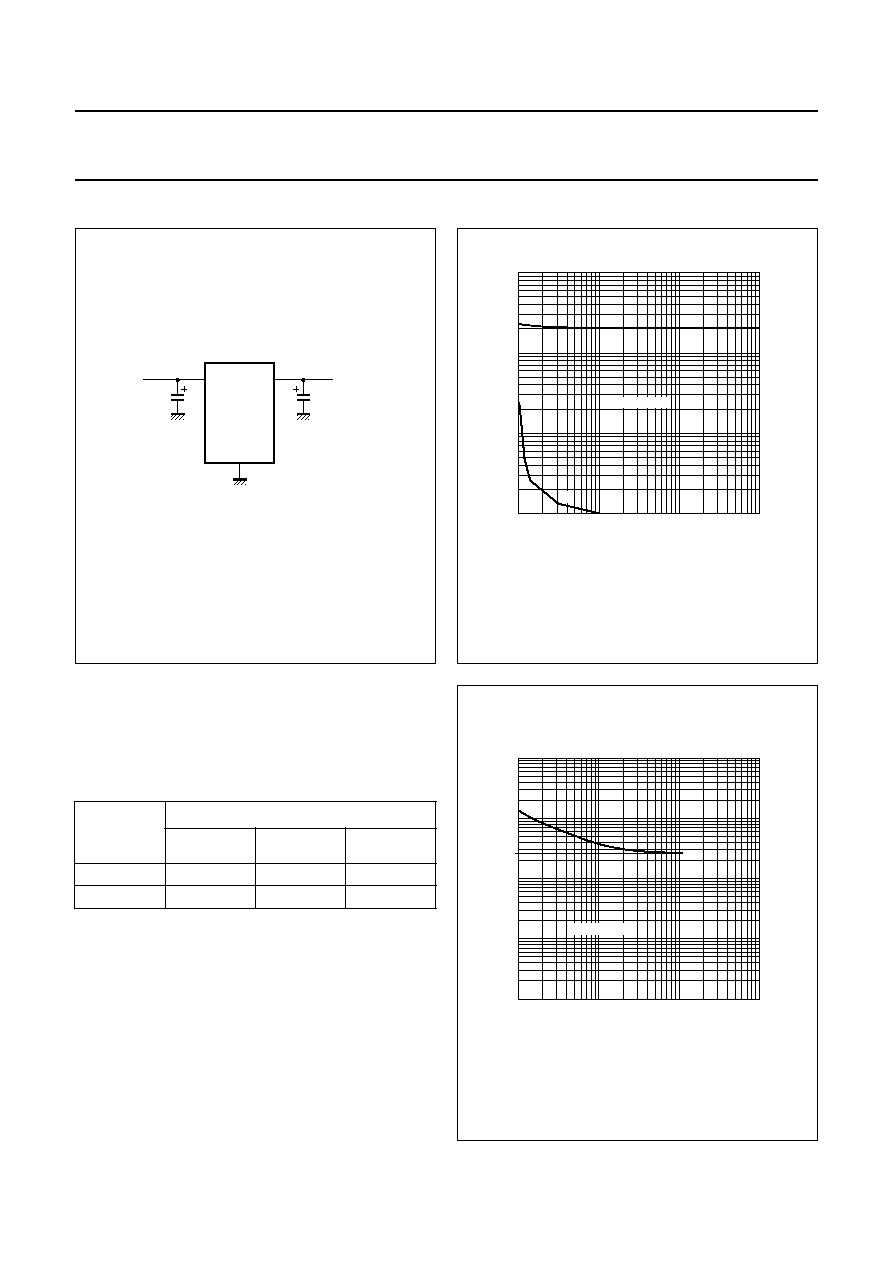
2000 Apr 25
7
Philips Semiconductors
Preliminary specification
Very low dropout voltage/quiescent current
8.5 V voltage regulator
TDA3665
TEST AND APPLICATION INFORMATION
ndbook, halfpage
MBL127
VP
1
3
2, 4
C2
TDA3665
10
µ
F
C1
1
µ
F
VREG = 8.5 V
Fig.4 Test circuit (SO4).
C1 is optional (to minimize supply noise only).
handbook, halfpage
MDA961
ESR
(
)
C2 (
µ
F)
10
2
10
1
10
-
1
10
-
1
1
10
10
2
stable region
(2)
(1)
Fig.5
Graph for selecting the value of the output
capacitor.
(1) Maximum ESR at 200
µ
A
I
REG
100 mA.
(2) Minimum ESR only when I
REG
200
µ
A.
Noise
The output noise is determined by the value of the output
capacitor. The noise figure is measured at a bandwidth of
10 Hz to 100 kHz (see Table 1).
Table 1
Noise figures
Stability
The regulator is stabilized with an external capacitor
connected to the output. The value of this capacitor can be
selected using the diagrams shown in Figs 5 and 6.
The following four examples show the effects of the
stabilization circuit using different values for the output
capacitor.
OUTPUT
CURRENT
I
REG
(mA)
NOISE FIGURE (
µ
V)
C2 = 10
µ
F
C2 = 47
µ
F
C2 = 100
µ
F
0.5
550
320
300
50
650
400
400
handbook, halfpage
MDA962
ESR
(
)
IREG (mA)
10
3
10
2
10
22
1
10
-
1
1
10
10
3
10
2
stable region
Fig.6
ESR as a function of I
REG
for selecting the
value of the output capacitor.
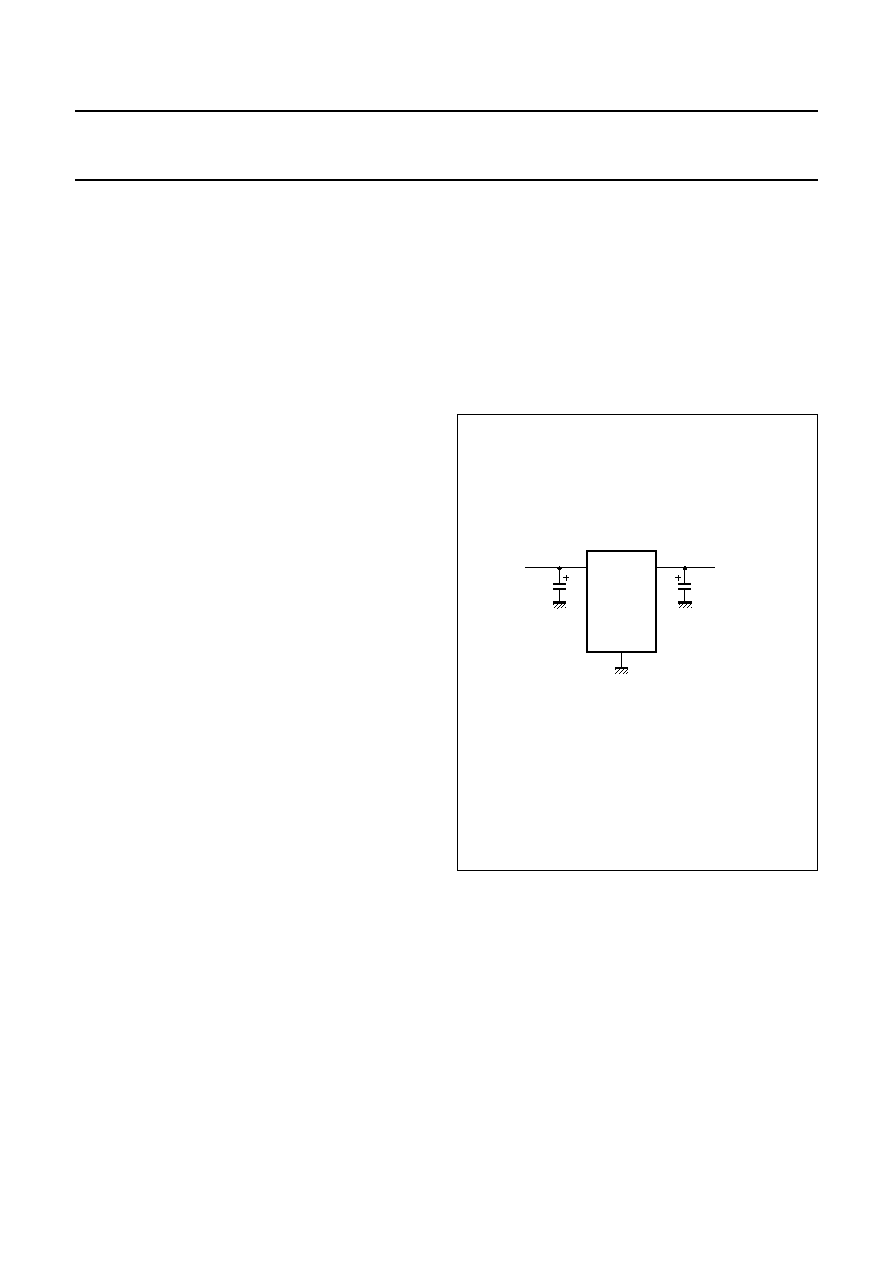
2000 Apr 25
8
Philips Semiconductors
Preliminary specification
Very low dropout voltage/quiescent current
8.5 V voltage regulator
TDA3665
E
XAMPLE
1
The regulator is stabilized with an electrolytic capacitor of
68
µ
F (ESR = 0.5
). At T
amb
=
-
40
∞
C, the capacitor
value is decreased to 22
µ
F and the ESR is increased
to 3.5
. The regulator will remain stable at a temperature
of T
amb
=
-
40
∞
C.
E
XAMPLE
2
The regulator is stabilized with an electrolytic capacitor of
10
µ
F (ESR = 3.3
). At T
amb
=
-
40
∞
C, the capacitor
value is decreased to 3
µ
F and the ESR is increased
to 20
. The regulator will remain stable at a temperature
of T
amb
=
-
40
∞
C.
E
XAMPLE
3
The regulator is stabilized with a 100 nF MKT capacitor
connected to the output. When the output current is over
200
µ
A full stability is guaranteed.
Because the thermal influence on the capacitor value is
almost zero, the regulator will remain stable at a
temperature of T
amb
=
-
40
∞
C.
E
XAMPLE
4
The regulator is stabilized with a 100 nF capacitor in
parallel with an electrolytic capacitor of 10
µ
F connected to
the output.
The regulator is now stable under all conditions and
independent of:
∑
The ESR of the electrolytic capacitor
∑
The value of the electrolytic capacitor
∑
The output current.
Application circuits
The maximum output current of the regulator equals:
When T
amb
= 21
∞
C and V
P
= 17.5 V the maximum output
current equals 140 mA.
The total thermal resistance of the TDA3665 can be
decreased from 125 to 50 K/W for the SO8 version. For
the SO4 version it can be decreased from 100 to 40 K/W
when GND pins 2 and 4 of the package are soldered to
the printed-circuit board.
Application circuit with backup function
Sometimes a backup function is needed to supply, for
example, a microcontroller for a short period of time when
the supply voltage spikes to 0 V (or even
-
1 V).
This function can easily be built with the TDA3665 by using
an output capacitor with a large value. When the supply
voltage is 0 V (or
-
1 V), only a small current will flow into
pin REG from this output capacitor (a few
µ
A).
The application circuit is given in Fig.7.
I
REG max
(
)
150
T
amb
≠
R
th j
a
≠
(
)
V
P
V
REG
≠
(
)
◊
-----------------------------------------------------------
=
150
T
amb
≠
100
V
P
8.5
≠
(
)
◊
------------------------------------------ mA
(
)
=
ndbook, halfpage
MBL128
VP
1
3
2, 4
C2
(2)
TDA3665
C1
1
µ
F
VREG = 8.5 V
Fig.7
Application circuit with backup function
(SO4 version).
C1 is optional (to minimize supply noise only).
C2
4700
µ
F.

2000 Apr 25
9
Philips Semiconductors
Preliminary specification
Very low dropout voltage/quiescent current
8.5 V voltage regulator
TDA3665
Additional application information
This section gives typical curves for various parameters measured on the TDA3665AT. Standard test conditions are:
V
P
= 14.4 V; T
amb
= 25
∞
C.
handbook, halfpage
0
10
VP (V)
Iq
(
µ
A)
20
30
25
0
20
15
10
5
MDA947
Fig.8
Quiescent current as a function of the
supply voltage.
I
REG
= 0 mA.
handbook, halfpage
0
10
50
4
3
1
0
2
20
30
VP (V)
Iq
(mA)
40
MDA949
Fig.9
Quiescent current increase as a function of
high supply voltage.
handbook, halfpage
-
40
0
(1)
(2)
160
2
1.5
0.5
0
1
40
80
Tj (
∞
C)
Iq
(mA)
120
MDA951
Fig.10 Quiescent current as a function of the
junction temperature.
(1) I
q
at 50 mA load.
(2) I
q
at 10 mA load.
handbook, halfpage
5
0.36
0.40
0.44
0.48
10
15
VP (V)
Iq
(mA)
25
20
MDA948
Fig.11 Quiescent current as a function of the
supply voltage.
I
REG
= 10 mA.
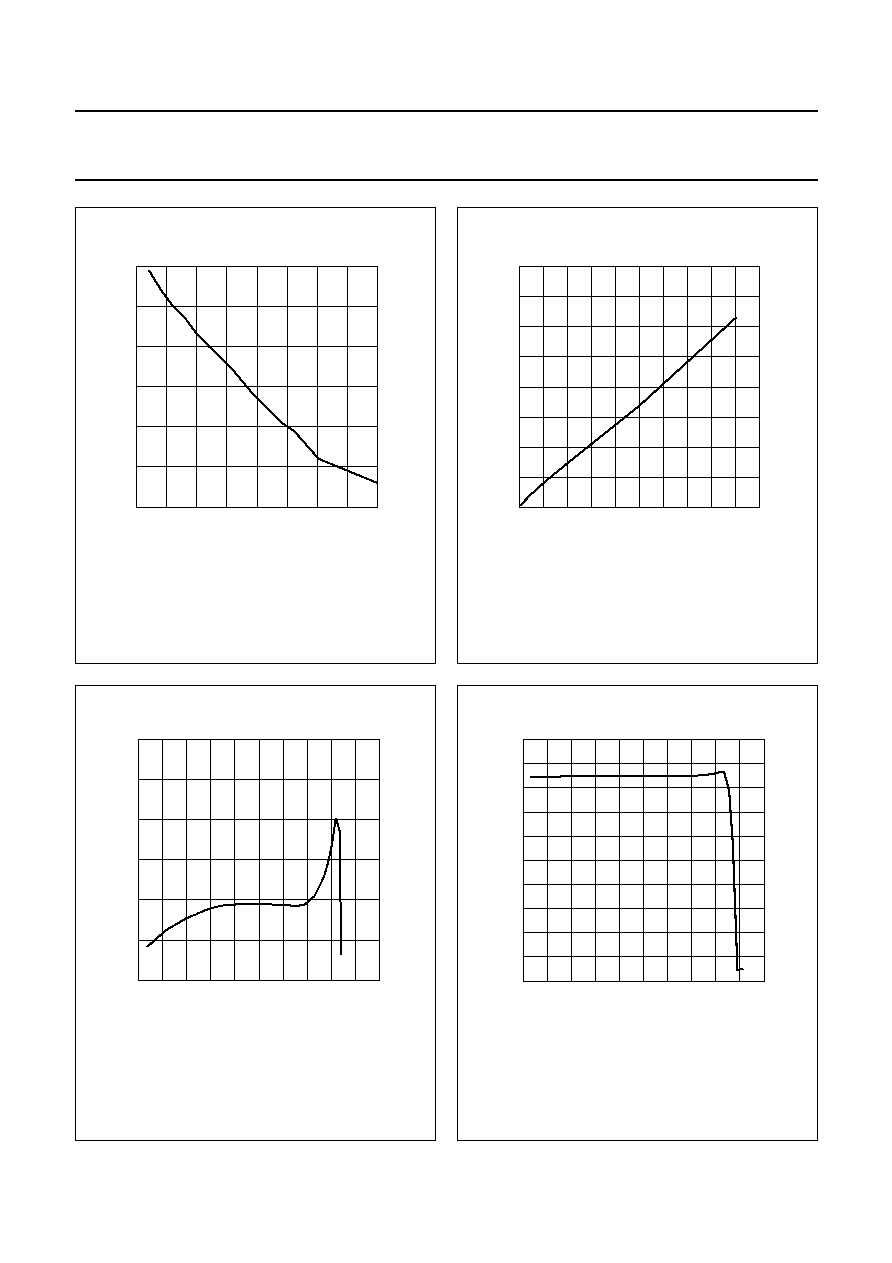
2000 Apr 25
10
Philips Semiconductors
Preliminary specification
Very low dropout voltage/quiescent current
8.5 V voltage regulator
TDA3665
handbook, halfpage
5
1.4
1.6
1.8
2
10
15
VP (V)
Iq
(mA)
25
20
MDA950
Fig.12 Quiescent current as a function of the
supply voltage.
I
REG
= 50 mA.
handbook, halfpage
0
20
100
4
3
1
0
2
40
60
IREG (mA)
Iq
(mA)
80
MDA952
Fig.13 Quiescent current as a function of the
output current.
handbook, halfpage
-
50
200
8.60
8.45
8.50
8.55
0
50
Tj (
∞
C)
VREG
(V)
100
150
MGU148
Fig.14 Output voltage as a function of the junction
temperature.
I
REG
= 0 mA.
handbook, halfpage
-
50
200
10
0
2
8
4
6
0
50
Tj (
∞
C)
VREG
(V)
100
150
MGU149
Fig.15 Output voltage thermal protection as a
function of the junction temperature.
I
REG
= 0 mA.
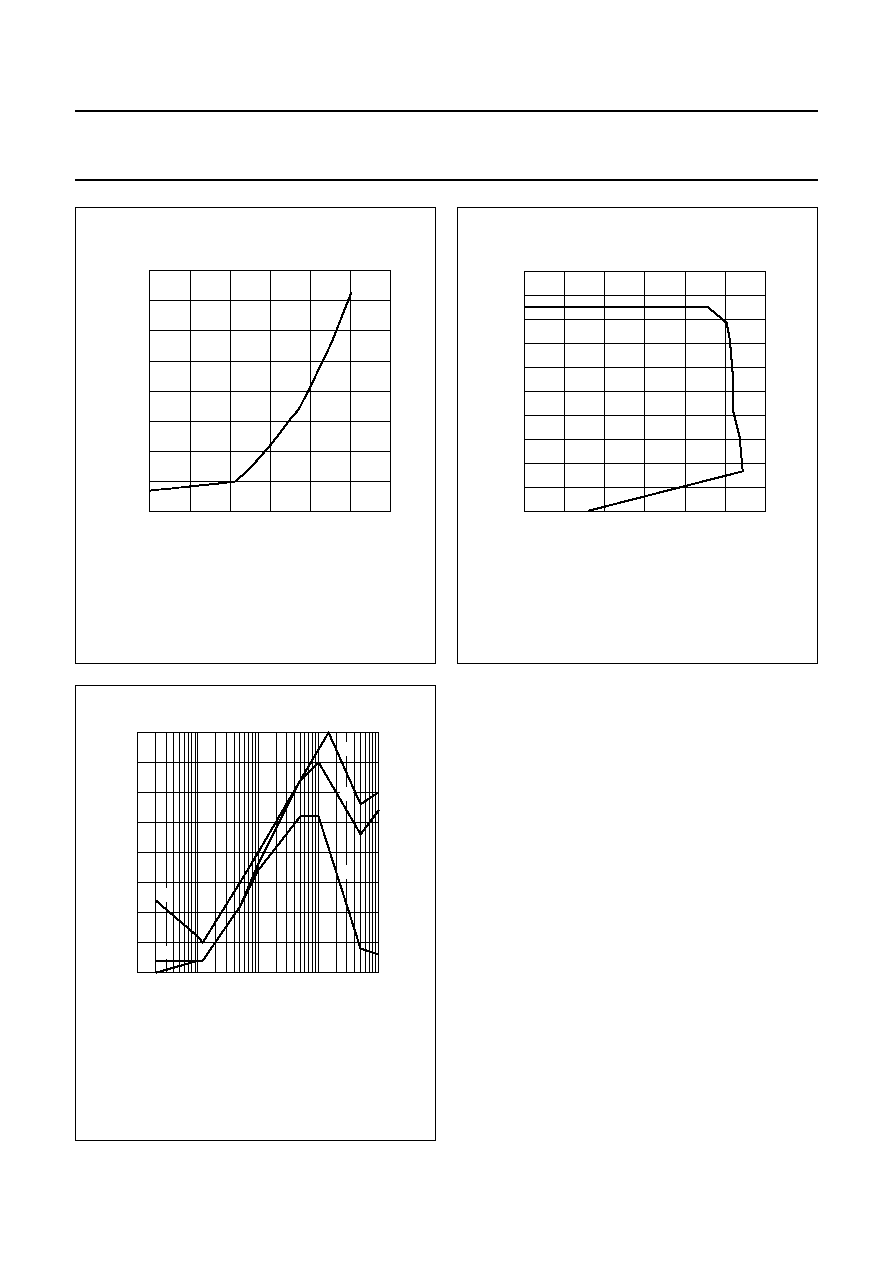
2000 Apr 25
11
Philips Semiconductors
Preliminary specification
Very low dropout voltage/quiescent current
8.5 V voltage regulator
TDA3665
handbook, halfpage
0
40
IREG (mA)
VREG(drop)
(mV)
80
120
500
400
200
100
300
MDA957
Fig.16 Dropout voltage as a function of the output
current.
handbook, halfpage
0
10
8
6
2
4
0
100
VREG
(V)
IREG (mA)
200
300
MGU150
Fig.17 Foldback protection mode.
V
P
= 10 V and pulsed load.
handbook, halfpage
-
70
-
60
-
50
-
40
-
30
MDA956
10
SVRR
(dB)
f (Hz)
10
2
10
3
10
4
10
5
(1)
(1)
(2)
(2)
(3)
(3)
C2 = 10
µ
F.
(1) SVRR at R
L
= 10 k
.
(2) SVRR at R
L
= 500
.
(3) SVRR at R
L
= 100
.
Fig.18 SVRR as a function of the ripple frequency.

2000 Apr 25
12
Philips Semiconductors
Preliminary specification
Very low dropout voltage/quiescent current
8.5 V voltage regulator
TDA3665
PACKAGE OUTLINES
UNIT
A2
bp
c
D
(1)
E
(1)
e1
HE
Lp
Q
y
w
v
REFERENCES
OUTLINE
VERSION
EUROPEAN
PROJECTION
ISSUE DATE
IEC
JEDEC
EIAJ
mm
1.7
1.5
A1
0.10
0.02
A3
0.25
1.8
0.85
0.65
b1
3.15
2.95
0.35
0.25
6.7
6.3
3.7
3.3
4.6
e
2.3
7.3
6.7
1.02
0.62
1.0
0.8
Z
1.2
0.7
10
∞
0
∞
0.1
0.1
0.2
L
1.75
DIMENSIONS (mm are the original dimensions)
SOT223-1
TO-261
99-08-04
99-12-15
w
M
bp
Z
D
b1
e1
e
A
A1
A2
(A3)
Lp
L
Q
detail X
HE
E
v
M
A
A
c
y
0
2
4 mm
scale
A
max.
X
1
3
2
4
SO4: plastic small outline package; 4 leads; body width 3.5 mm
SOT223-1
Note
1. Plastic or metal protrusions of 0.15 mm maximum per side are not included.

2000 Apr 25
13
Philips Semiconductors
Preliminary specification
Very low dropout voltage/quiescent current
8.5 V voltage regulator
TDA3665
UNIT
A
max.
A
1
A
2
A
3
b
p
c
D
(1)
E
(2)
(1)
e
H
E
L
L
p
Q
Z
y
w
v
REFERENCES
OUTLINE
VERSION
EUROPEAN
PROJECTION
ISSUE DATE
IEC
JEDEC
EIAJ
mm
inches
1.75
0.25
0.10
1.45
1.25
0.25
0.49
0.36
0.25
0.19
5.0
4.8
4.0
3.8
1.27
6.2
5.8
1.05
0.7
0.6
0.7
0.3
8
0
o
o
0.25
0.1
0.25
DIMENSIONS (inch dimensions are derived from the original mm dimensions)
Notes
1. Plastic or metal protrusions of 0.15 mm maximum per side are not included.
2. Plastic or metal protrusions of 0.25 mm maximum per side are not included.
1.0
0.4
SOT96-1
X
w
M
A
A
1
A
2
b
p
D
H
E
L
p
Q
detail X
E
Z
e
c
L
v
M
A
(A )
3
A
4
5
pin 1 index
1
8
y
076E03
MS-012
0.069
0.010
0.004
0.057
0.049
0.01
0.019
0.014
0.0100
0.0075
0.20
0.19
0.16
0.15
0.050
0.244
0.228
0.028
0.024
0.028
0.012
0.01
0.01
0.041
0.004
0.039
0.016
0
2.5
5 mm
scale
SO8: plastic small outline package; 8 leads; body width 3.9 mm
SOT96-1
97-05-22
99-12-27

2000 Apr 25
14
Philips Semiconductors
Preliminary specification
Very low dropout voltage/quiescent current
8.5 V voltage regulator
TDA3665
SOLDERING
Introduction to soldering surface mount packages
This text gives a very brief insight to a complex technology.
A more in-depth account of soldering ICs can be found in
our
"Data Handbook IC26; Integrated Circuit Packages"
(document order number 9398 652 90011).
There is no soldering method that is ideal for all surface
mount IC packages. Wave soldering is not always suitable
for surface mount ICs, or for printed-circuit boards with
high population densities. In these situations reflow
soldering is often used.
Reflow soldering
Reflow soldering requires solder paste (a suspension of
fine solder particles, flux and binding agent) to be applied
to the printed-circuit board by screen printing, stencilling or
pressure-syringe dispensing before package placement.
Several methods exist for reflowing; for example,
infrared/convection heating in a conveyor type oven.
Throughput times (preheating, soldering and cooling) vary
between 100 and 200 seconds depending on heating
method.
Typical reflow peak temperatures range from
215 to 250
∞
C. The top-surface temperature of the
packages should preferable be kept below 230
∞
C.
Wave soldering
Conventional single wave soldering is not recommended
for surface mount devices (SMDs) or printed-circuit boards
with a high component density, as solder bridging and
non-wetting can present major problems.
To overcome these problems the double-wave soldering
method was specifically developed.
If wave soldering is used the following conditions must be
observed for optimal results:
∑
Use a double-wave soldering method comprising a
turbulent wave with high upward pressure followed by a
smooth laminar wave.
∑
For packages with leads on two sides and a pitch (e):
≠ larger than or equal to 1.27 mm, the footprint
longitudinal axis is preferred to be parallel to the
transport direction of the printed-circuit board;
≠ smaller than 1.27 mm, the footprint longitudinal axis
must be parallel to the transport direction of the
printed-circuit board.
The footprint must incorporate solder thieves at the
downstream end.
∑
For packages with leads on four sides, the footprint must
be placed at a 45
∞
angle to the transport direction of the
printed-circuit board. The footprint must incorporate
solder thieves downstream and at the side corners.
During placement and before soldering, the package must
be fixed with a droplet of adhesive. The adhesive can be
applied by screen printing, pin transfer or syringe
dispensing. The package can be soldered after the
adhesive is cured.
Typical dwell time is 4 seconds at 250
∞
C.
A mildly-activated flux will eliminate the need for removal
of corrosive residues in most applications.
Manual soldering
Fix the component by first soldering two
diagonally-opposite end leads. Use a low voltage (24 V or
less) soldering iron applied to the flat part of the lead.
Contact time must be limited to 10 seconds at up to
300
∞
C.
When using a dedicated tool, all other leads can be
soldered in one operation within 2 to 5 seconds between
270 and 320
∞
C.

2000 Apr 25
15
Philips Semiconductors
Preliminary specification
Very low dropout voltage/quiescent current
8.5 V voltage regulator
TDA3665
Suitability of surface mount IC packages for wave and reflow soldering methods
Notes
1. All surface mount (SMD) packages are moisture sensitive. Depending upon the moisture content, the maximum
temperature (with respect to time) and body size of the package, there is a risk that internal or external package
cracks may occur due to vaporization of the moisture in them (the so called popcorn effect). For details, refer to the
Drypack information in the
"Data Handbook IC26; Integrated Circuit Packages; Section: Packing Methods".
2. These packages are not suitable for wave soldering as a solder joint between the printed-circuit board and heatsink
(at bottom version) can not be achieved, and as solder may stick to the heatsink (on top version).
3. If wave soldering is considered, then the package must be placed at a 45
∞
angle to the solder wave direction.
The package footprint must incorporate solder thieves downstream and at the side corners.
4. Wave soldering is only suitable for LQFP, TQFP and QFP packages with a pitch (e) equal to or larger than 0.8 mm;
it is definitely not suitable for packages with a pitch (e) equal to or smaller than 0.65 mm.
5. Wave soldering is only suitable for SSOP and TSSOP packages with a pitch (e) equal to or larger than 0.65 mm; it is
definitely not suitable for packages with a pitch (e) equal to or smaller than 0.5 mm.
PACKAGE
SOLDERING METHOD
WAVE
REFLOW
(1)
BGA, SQFP
not suitable
suitable
HLQFP, HSQFP, HSOP, HTSSOP, SMS
not suitable
(2)
suitable
PLCC
(3)
, SO, SOJ
suitable
suitable
LQFP, QFP, TQFP
not recommended
(3)(4)
suitable
SSOP, TSSOP, VSO
not recommended
(5)
suitable
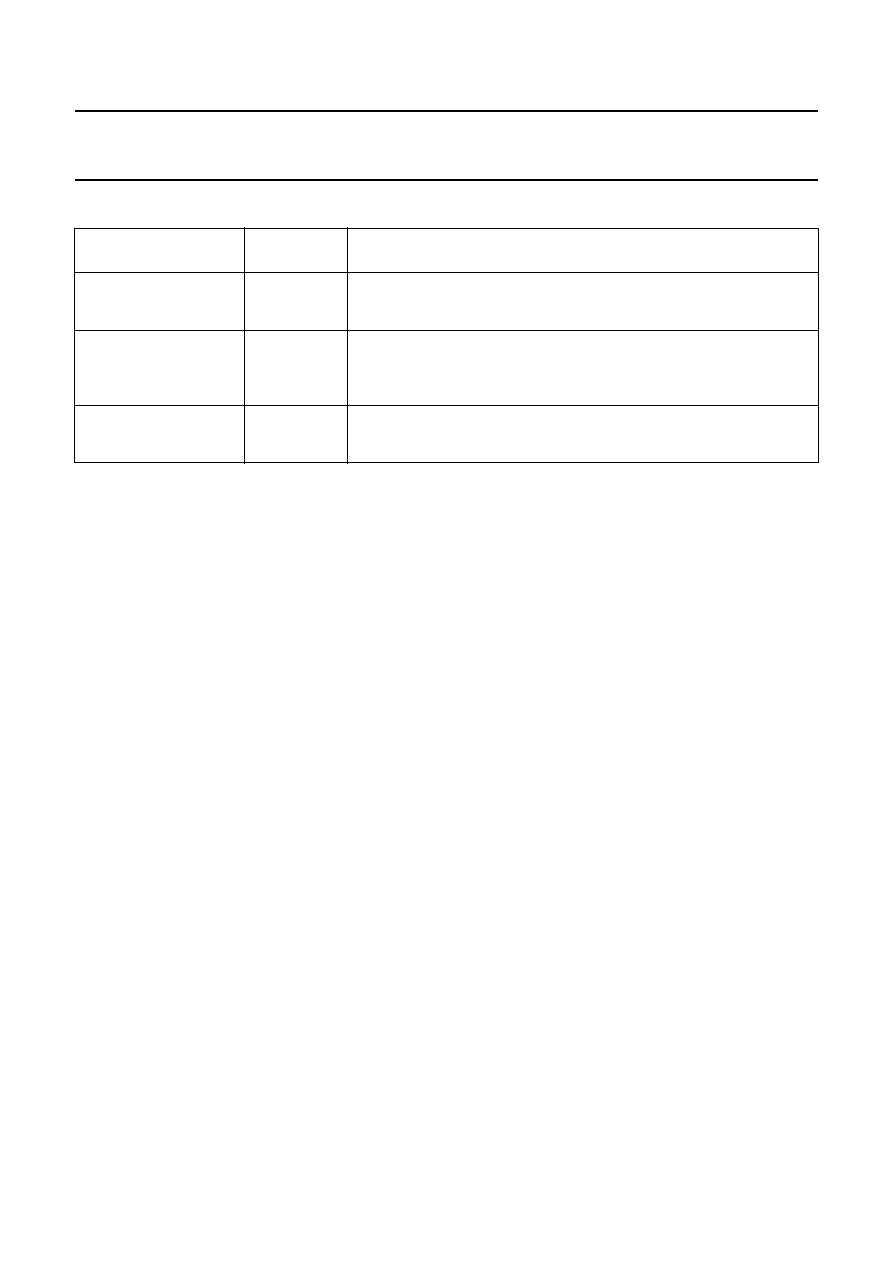
2000 Apr 25
16
Philips Semiconductors
Preliminary specification
Very low dropout voltage/quiescent current
8.5 V voltage regulator
TDA3665
DATA SHEET STATUS
Note
1. Please consult the most recently issued data sheet before initiating or completing a design.
DATA SHEET STATUS
PRODUCT
STATUS
DEFINITIONS
(1)
Objective specification
Development
This data sheet contains the design target or goal specifications for
product development. Specification may change in any manner without
notice.
Preliminary specification
Qualification
This data sheet contains preliminary data, and supplementary data will be
published at a later date. Philips Semiconductors reserves the right to
make changes at any time without notice in order to improve design and
supply the best possible product.
Product specification
Production
This data sheet contains final specifications. Philips Semiconductors
reserves the right to make changes at any time without notice in order to
improve design and supply the best possible product.
DEFINITIONS
Short-form specification
The data in a short-form
specification is extracted from a full data sheet with the
same type number and title. For detailed information see
the relevant data sheet or data handbook.
Limiting values definition
Limiting values given are in
accordance with the Absolute Maximum Rating System
(IEC 60134). Stress above one or more of the limiting
values may cause permanent damage to the device.
These are stress ratings only and operation of the device
at these or at any other conditions above those given in the
Characteristics sections of the specification is not implied.
Exposure to limiting values for extended periods may
affect device reliability.
Application information
Applications that are
described herein for any of these products are for
illustrative purposes only. Philips Semiconductors make
no representation or warranty that such applications will be
suitable for the specified use without further testing or
modification.
DISCLAIMERS
Life support applications
These products are not
designed for use in life support appliances, devices, or
systems where malfunction of these products can
reasonably be expected to result in personal injury. Philips
Semiconductors customers using or selling these products
for use in such applications do so at their own risk and
agree to fully indemnify Philips Semiconductors for any
damages resulting from such application.
Right to make changes
Philips Semiconductors
reserves the right to make changes, without notice, in the
products, including circuits, standard cells, and/or
software, described or contained herein in order to
improve design and/or performance. Philips
Semiconductors assumes no responsibility or liability for
the use of any of these products, conveys no licence or title
under any patent, copyright, or mask work right to these
products, and makes no representations or warranties that
these products are free from patent, copyright, or mask
work right infringement, unless otherwise specified.

2000 Apr 25
17
Philips Semiconductors
Preliminary specification
Very low dropout voltage/quiescent current
8.5 V voltage regulator
TDA3665
NOTES

2000 Apr 25
18
Philips Semiconductors
Preliminary specification
Very low dropout voltage/quiescent current
8.5 V voltage regulator
TDA3665
NOTES

2000 Apr 25
19
Philips Semiconductors
Preliminary specification
Very low dropout voltage/quiescent current
8.5 V voltage regulator
TDA3665
NOTES

© Philips Electronics N.V.
SCA
All rights are reserved. Reproduction in whole or in part is prohibited without the prior written consent of the copyright owner.
The information presented in this document does not form part of any quotation or contract, is believed to be accurate and reliable and may be changed
without notice. No liability will be accepted by the publisher for any consequence of its use. Publication thereof does not convey nor imply any license
under patent- or other industrial or intellectual property rights.
Internet: http://www.semiconductors.philips.com
2000
69
Philips Semiconductors ≠ a worldwide company
For all other countries apply to: Philips Semiconductors,
International Marketing & Sales Communications, Building BE-p, P.O. Box 218,
5600 MD EINDHOVEN, The Netherlands, Fax. +31 40 27 24825
Argentina: see South America
Australia: 3 Figtree Drive, HOMEBUSH, NSW 2140,
Tel. +61 2 9704 8141, Fax. +61 2 9704 8139
Austria: Computerstr. 6, A-1101 WIEN, P.O. Box 213,
Tel. +43 1 60 101 1248, Fax. +43 1 60 101 1210
Belarus: Hotel Minsk Business Center, Bld. 3, r. 1211, Volodarski Str. 6,
220050 MINSK, Tel. +375 172 20 0733, Fax. +375 172 20 0773
Belgium: see The Netherlands
Brazil: see South America
Bulgaria: Philips Bulgaria Ltd., Energoproject, 15th floor,
51 James Bourchier Blvd., 1407 SOFIA,
Tel. +359 2 68 9211, Fax. +359 2 68 9102
Canada: PHILIPS SEMICONDUCTORS/COMPONENTS,
Tel. +1 800 234 7381, Fax. +1 800 943 0087
China/Hong Kong: 501 Hong Kong Industrial Technology Centre,
72 Tat Chee Avenue, Kowloon Tong, HONG KONG,
Tel. +852 2319 7888, Fax. +852 2319 7700
Colombia: see South America
Czech Republic: see Austria
Denmark: Sydhavnsgade 23, 1780 COPENHAGEN V,
Tel. +45 33 29 3333, Fax. +45 33 29 3905
Finland: Sinikalliontie 3, FIN-02630 ESPOO,
Tel. +358 9 615 800, Fax. +358 9 6158 0920
France: 51 Rue Carnot, BP317, 92156 SURESNES Cedex,
Tel. +33 1 4099 6161, Fax. +33 1 4099 6427
Germany: Hammerbrookstraþe 69, D-20097 HAMBURG,
Tel. +49 40 2353 60, Fax. +49 40 2353 6300
Hungary: see Austria
India: Philips INDIA Ltd, Band Box Building, 2nd floor,
254-D, Dr. Annie Besant Road, Worli, MUMBAI 400 025,
Tel. +91 22 493 8541, Fax. +91 22 493 0966
Indonesia: PT Philips Development Corporation, Semiconductors Division,
Gedung Philips, Jl. Buncit Raya Kav.99-100, JAKARTA 12510,
Tel. +62 21 794 0040 ext. 2501, Fax. +62 21 794 0080
Ireland: Newstead, Clonskeagh, DUBLIN 14,
Tel. +353 1 7640 000, Fax. +353 1 7640 200
Israel: RAPAC Electronics, 7 Kehilat Saloniki St, PO Box 18053,
TEL AVIV 61180, Tel. +972 3 645 0444, Fax. +972 3 649 1007
Italy: PHILIPS SEMICONDUCTORS, Via Casati, 23 - 20052 MONZA (MI),
Tel. +39 039 203 6838, Fax +39 039 203 6800
Japan: Philips Bldg 13-37, Kohnan 2-chome, Minato-ku,
TOKYO 108-8507, Tel. +81 3 3740 5130, Fax. +81 3 3740 5057
Korea: Philips House, 260-199 Itaewon-dong, Yongsan-ku, SEOUL,
Tel. +82 2 709 1412, Fax. +82 2 709 1415
Malaysia: No. 76 Jalan Universiti, 46200 PETALING JAYA, SELANGOR,
Tel. +60 3 750 5214, Fax. +60 3 757 4880
Mexico: 5900 Gateway East, Suite 200, EL PASO, TEXAS 79905,
Tel. +9-5 800 234 7381, Fax +9-5 800 943 0087
Middle East: see Italy
Netherlands: Postbus 90050, 5600 PB EINDHOVEN, Bldg. VB,
Tel. +31 40 27 82785, Fax. +31 40 27 88399
New Zealand: 2 Wagener Place, C.P.O. Box 1041, AUCKLAND,
Tel. +64 9 849 4160, Fax. +64 9 849 7811
Norway: Box 1, Manglerud 0612, OSLO,
Tel. +47 22 74 8000, Fax. +47 22 74 8341
Pakistan: see Singapore
Philippines: Philips Semiconductors Philippines Inc.,
106 Valero St. Salcedo Village, P.O. Box 2108 MCC, MAKATI,
Metro MANILA, Tel. +63 2 816 6380, Fax. +63 2 817 3474
Poland: Al.Jerozolimskie 195 B, 02-222 WARSAW,
Tel. +48 22 5710 000, Fax. +48 22 5710 001
Portugal: see Spain
Romania: see Italy
Russia: Philips Russia, Ul. Usatcheva 35A, 119048 MOSCOW,
Tel. +7 095 755 6918, Fax. +7 095 755 6919
Singapore: Lorong 1, Toa Payoh, SINGAPORE 319762,
Tel. +65 350 2538, Fax. +65 251 6500
Slovakia: see Austria
Slovenia: see Italy
South Africa: S.A. PHILIPS Pty Ltd., 195-215 Main Road Martindale,
2092 JOHANNESBURG, P.O. Box 58088 Newville 2114,
Tel. +27 11 471 5401, Fax. +27 11 471 5398
South America: Al. Vicente Pinzon, 173, 6th floor,
04547-130 S√O PAULO, SP, Brazil,
Tel. +55 11 821 2333, Fax. +55 11 821 2382
Spain: Balmes 22, 08007 BARCELONA,
Tel. +34 93 301 6312, Fax. +34 93 301 4107
Sweden: Kottbygatan 7, Akalla, S-16485 STOCKHOLM,
Tel. +46 8 5985 2000, Fax. +46 8 5985 2745
Switzerland: Allmendstrasse 140, CH-8027 ZÐRICH,
Tel. +41 1 488 2741 Fax. +41 1 488 3263
Taiwan: Philips Semiconductors, 6F, No. 96, Chien Kuo N. Rd., Sec. 1,
TAIPEI, Taiwan Tel. +886 2 2134 2886, Fax. +886 2 2134 2874
Thailand: PHILIPS ELECTRONICS (THAILAND) Ltd.,
209/2 Sanpavuth-Bangna Road Prakanong, BANGKOK 10260,
Tel. +66 2 745 4090, Fax. +66 2 398 0793
Turkey: Yukari Dudullu, Org. San. Blg., 2.Cad. Nr. 28 81260 Umraniye,
ISTANBUL, Tel. +90 216 522 1500, Fax. +90 216 522 1813
Ukraine: PHILIPS UKRAINE, 4 Patrice Lumumba str., Building B, Floor 7,
252042 KIEV, Tel. +380 44 264 2776, Fax. +380 44 268 0461
United Kingdom: Philips Semiconductors Ltd., 276 Bath Road, Hayes,
MIDDLESEX UB3 5BX, Tel. +44 208 730 5000, Fax. +44 208 754 8421
United States: 811 East Arques Avenue, SUNNYVALE, CA 94088-3409,
Tel. +1 800 234 7381, Fax. +1 800 943 0087
Uruguay: see South America
Vietnam: see Singapore
Yugoslavia: PHILIPS, Trg N. Pasica 5/v, 11000 BEOGRAD,
Tel. +381 11 3341 299, Fax.+381 11 3342 553
Printed in The Netherlands
753503/25/01/pp
20
Date of release:
2000 Apr 25
Document order number:
9397 750 06702



















